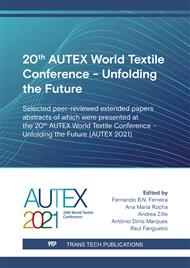[1]
M. Sauer, Composites Market Report 2019 - The global CF- and CC-Market 2019 - Market Developments, Trends, Outlook and Challenges,, Composites United e.V., Germany2020.
Google Scholar
[2]
M. S. Schade W., Lembke M, Analysis of the light weight fiber reinforced plastics value chain with regard to the German industry in its global context,, M-Five working paper on behalf of the ECF and Cambridge Econometrics. Karlsruhe, (2017).
Google Scholar
[3]
F. Meng, J. McKechnie, and S. J. Pickering, An assessment of financial viability of recycled carbon fibre in automotive applications,, Composites Part A: Applied Science and Manufacturing, vol. 109, pp.207-220, (2018).
DOI: 10.1016/j.compositesa.2018.03.011
Google Scholar
[4]
H. Mainka et al., Lignin – an alternative precursor for sustainable and cost-effective automotive carbon fiber,, Journal of Materials Research and Technology, vol. 4, no. 3, pp.283-296, (2015).
DOI: 10.1016/j.jmrt.2015.03.004
Google Scholar
[5]
K. Friedrich and A. A. Almajid, Manufacturing aspects of advanced polymer composites for automotive applications,, Applied Composite Material, vol. 20, pp.107-128, (2013).
DOI: 10.1007/s10443-012-9258-7
Google Scholar
[6]
S.R. Naqvi, H. Mysore Prabhakar, E.A. Bramer, W. Dierkesa, R. Akkerman, G. Brem, A critical review on recycling of end-of-life carbon fibre/glass fibre reinforced composites waste using pyrolysis towards a circular economy,, Resources, Conservation & Recycling, vol. 36, p.118–129, (2018).
DOI: 10.1016/j.resconrec.2018.04.013
Google Scholar
[7]
S. Karuppannan Gopalraj and T. Kärki, A review on the recycling of waste carbon fibre/glass fibre-reinforced composites: fibre recovery, properties and life-cycle analysis,, SN Applied Sciences, vol. 2, no. 3, (2020).
DOI: 10.1007/s42452-020-2195-4
Google Scholar
[8]
Y. F. Khalil, Comparative environmental and human health evaluations of thermolysis and solvolysis recycling technologies of carbon fiber reinforced polymer waste,, Waste Management, vol. March 2018, no. xxx, p. xxx, (2018).
DOI: 10.1016/j.wasman.2018.03.026
Google Scholar
[9]
G. Oliveux, L. O. Dandy, and G. A. Leeke, Current status of recycling of fibre reinforced polymers: Review of technologies, reuse and resulting properties,, Progress in Materials Science, vol. 72, pp.61-99, (2015).
DOI: 10.1016/j.pmatsci.2015.01.004
Google Scholar
[10]
E. Pakdel, S. Kashi, R. Varley, and X. Wang, Recent progress in recycling carbon fibre reinforced composites and dry carbon fibre wastes,, Resources, Conservation and Recycling, vol. 166, (2021).
DOI: 10.1016/j.resconrec.2020.105340
Google Scholar
[11]
J. Zhang, V. S. Chevali, H. Wang, and C.-H. Wang, Current status of carbon fibre and carbon fibre composites recycling,, Composites Part B: Engineering, vol. 193, (2020).
DOI: 10.1016/j.compositesb.2020.108053
Google Scholar
[12]
A. Jacob. (2019) Building confidence in recycled carbon fibe. Composites World. 26-33.
Google Scholar
[13]
M. F. Khurshid, M. Hengstermann, Mir Mohammad Badrul Hasan, A. Abdkader, and C. Cherif, Recent developments in the processing of waste carbon fibre for thermoplastic composites – A review,, Journal of Composite Materials, vol. 54, no. 14, pp.1925-1944, (2020).
DOI: 10.1177/0021998319886043
Google Scholar
[14]
L. P. Kollar and G. S. Springer, Mechanics of Composite Structures. Cambridge, New York, Melbourne, Madrid, Cape Town, Singapore, São Paulo: Cambridge university press, (2003).
Google Scholar
[15]
Muhammad Furqan Khurshid, A. Abdkader, and C. Cherif, Processing of waste carbon and polyamide fibres for high performance thermoplastic composites: Influence of carding parameters on fibre orientation, fibre length and sliver cohesion force , Journal of the Textile Institute, vol. 111, no. 9, p.1277–1287, (2020).
DOI: 10.1080/00405000.2019.1690918
Google Scholar
[16]
M. F. Khurshid, M. Hillerbrand, A. Abdkader, and C. Cherif, Processing of waste carbon and polyamide fibers for high-performance thermoplastic composites: Modifications to the auto-leveling system to enhance the quality of hybrid drawn sliver,, Journal of Industrial Textiles, (2020).
DOI: 10.1177/1528083720913530
Google Scholar
[17]
C. H. Lindsley, Measurement of Fiber Orientation,, Textile Research Journal, vol. January, pp.39-46, (1951).
Google Scholar
[18]
C. A. Lawrence, Fundamentals of spun yarn technology. Boca Raton London New York Washington, D.C.: CRC PRESS, (2003).
Google Scholar
[19]
D. Das, S. M. Ishtiaque, and P. Dixit, Influence of carding and drawing processes on orientation of fibers in slivers,, Journal of the Textile Institute, vol. 103, no. 6, pp.676-686, (2012).
DOI: 10.1080/00405000.2011.598667
Google Scholar



